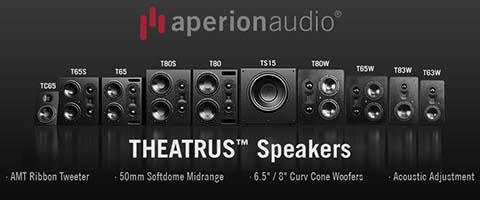 There’s nothing more exciting that setting up your home theater speakers. You’ve spent months doing your research to find the perfect components that you need to bring a multiplex home cinema experience to your living room, so don’t take any shortcuts that will compromise their performance. We’ll cover a few of the most common home theater system mistakes that can be easily avoided or fixed so your system will have you smiling from ear to ear.
There’s nothing more exciting that setting up your home theater speakers. You’ve spent months doing your research to find the perfect components that you need to bring a multiplex home cinema experience to your living room, so don’t take any shortcuts that will compromise their performance. We’ll cover a few of the most common home theater system mistakes that can be easily avoided or fixed so your system will have you smiling from ear to ear.
- - - - - - - - - - - - - - - - - - - - - - - - - - - - - - - - - - - - - - - - - - - - - - - - - - - - - - - - - - - - - - - -
1. Auditioning the speakers in the store only.
When you begin auditioning home theater speakers you’re going to find that you can either listen to speakers in a beautifully designed and acoustically treated showroom or, on the floor of a big box store. In both instances, the listening environment is going to be nothing like your home. Without a doubt, home speakers that you hear at a store will sound drastically different once you get them in your own home due to the size of your room, placement, furniture, electronics, floor material and ceiling height, just to name a few. In fact your room is more likely to affect the sound of the speakers than any of your other components. Even at our Aperion Audio showroom we’ve spent a large amount of time positioning and calibrating our speakers and electronics, as well as adding room treatments to quiet the space in order make sure our speakers sound as good as possible. In-home auditions will answer the most important purchasing criteria which should be, if the speakers sound good to you, in your home, with your music an d is probably the most common home theater mistake that should be avoided.
- - - - - - - - - - - - - - - - - - - - - - - - - - - - - - - - - - - - - - - - - - - - - - - - - - - - - - - - - - - - - - - -
2. Placing speakers where it’s simply convenient
As I mentioned in common mistake #1, listening to your speakers in your own room is critical. To take that one step further, the placement of home theater speakers and your TV is extremely important. For your TV, distance and height are the important factors. You should know how far back you plan on sitting from the TV before you purchase it. A quick rule of thumb is to take the diagonal size of your TV screen and multiply it by 1.5 (THX recommends between 1.2 and 1.8x your screen diagonal) . That number will give you the “optimum” viewing distance but keep in mind that you’ll also want that TV at eye level as well (eyes in the middle of the screen). A common theme we often see with new construction is wiring for your flat panel above your fireplace which may look cool, but your neck is going to hurt from looking up that high for the length of a movie.
Speaker placement is equally important and will have a great impact on how your speakers will sound. If you can, try and pull your home speakers out into the room a few feet both from the side walls and rear walls as well. What this will do is allow you to hear more of the speakers and less of the room reflections. In order to achieve great soundstage and imaging your speakers need to have a clear sound path to your ears. For example, if you were to push speakers right up against the back wall on either side of your entertainment system the path of sound those speakers product will be inhibited by the side walls of the equipment cabinet. What you’ll miss is stereo imaging and the 3D spaciousness that a properly setup stereo system can provide. Ideally, as the diagram shows above, having your speakers pulled forward of obstructions and slightly angled inward will greatly improve the entire systems performance. Don’t make the mistake of taking speaker placement casually. It’s all about location, location, location!
- - - - - - - - - - - - - - - - - - - - - - - - - - - - - - - - - - - - - - - - - - - - - - - - - - - - - - - - - - - - - - - -
3. Skipping the calibration of your receiver and TV

We all want to get to the fun part, but it only takes a little patience to get optimal results. Don’t skip calibrating your receiver as well as your TV. Calibration settings in your receiver are quite common these days. Even some entry level receivers will come with a setup microphone and some level of Audessy auto calibration. I recommend Audessy and find that it will calibrate a receiver to satisfactory settings and dial your speaker system into your room. One tip is to use a microphone to isolate the Audessy mic for best performance. Placing the mic on the back of the couch isn’t the best option as any obstructions can affect the quality of the test tones it needs for setup. I always recommend customers to use a tripod if possible and place the tip of the microphone exactly where their head is going to be when sitting down. One last item to keep in mind when using Audessy would be to turn the level of your subwoofer down to maybe 1/3 or 1/2 volume and always double check your channel level when the calibration is done. If you see large variances in volume level, especially from the surrounds or subwoofer, chances are you didn’t get a clean reading and should try again.
Calibrating your TV is something I recommend to everyone who purchases a new TV. Out of the box TV’s are usually set to some type of super bright setting that would stand out in a big box retail store. Please, take the time and calibrate your main HDMI input in the advance settings. What I would recommend doing is looking on AVS forum or Cnet for TV reviews on your make and model and often times you’ll find someone who will publish and ISF calibration guide with all of the numbers you need. Set aside about 30 minutes and go through the 100 or so settings and you’ll be amazed at the difference in picture quality. I was skeptical when I bought my first 1080p display, but after I went through ISF settings the picture was more balanced, detailed and lifelike.
- - - - - - - - - - - - - - - - - - - - - - - - - - - - - - - - - - - - - - - - - - - - - - - - - - - - - - - - - - - - - - - -
4. Using the wrong audio cables
This is a touchy subject because while I think there is a genuine advantage to be had from using well built audio cables and heavier gauge speaker wire, I’m a bit skeptical in regards to digital cables. Most notably in my opinion are “High End” HDMI cables. A common home theater mistake is to spend above and beyond on HDMI cables when the same quality signal can be had from a generic cable for a fraction of the price. There are different levels of features within HDMI, but just always for the highest feature level of HDMI cable you can get. Look for cables that support “high speed” Ethernet, 3D, and ARC.
- - - - - - - - - - - - - - - - - - - - - - - - - - - - - - - - - - - - - - - - - - - - - - - - - - - - - - - - - - - - - - - -
5. Using poor source material
This happens more that I would like to admit, but often times I’ll help a customer put together perfect system for their needs and they’ll call me back feeling a bit underwhelmed by the sound. When I ask what they are playing, it’s usually a low quality mp3…sigh. Another common issue is using your awesome 1080p HDTV to watch standard definition TV; it looks horrible. Remember: Quality in, quality out. You’ve spent the time and money on your gear so please make sure to use high quality source material! You deserve it! HDTV and Blu Ray for your TV and CD’s, SACD or loss-less audio downloads for music. Your eyes and ears will thank you, and your system will eat it up!
Check out our new YouTube videos!

Complete Your Sound System Solution

Sign up for our newsletter below, and join our social media groups to stay up to date with the latest news and information from Aperion Audio!
 |
 |






 https://www.aperionaudio.com
https://www.aperionaudio.com